
Villa Allatini is a three-storey baroque building on Queen Olga's Avenue in the area of Depot in the east of the Municipality of Thessaloniki, Greece. It was constructed in 1898 when Thessaloniki was part of the Ottoman Empire.

Villa Allatini is a three-storey baroque building on Queen Olga's Avenue in the area of Depot in the east of the Municipality of Thessaloniki, Greece. It was constructed in 1898 when Thessaloniki was part of the Ottoman Empire.
It was built in 1898 by the Italian architect Vitaliano Poselli, [1] who also designed the Mills of Allatini that were founded in 1890, and the head office of Allatini-affiliated Banque de Salonique in downtown Thessaloniki. At that time the region where the villa is located was called the district of "Countrysides" (des Campagnes) or "Towers", and was the easternmost limit of Thessaloniki. [2]
In the first period of its use, the villa was the countryside residence of the Salonica Jewish Allatini family. After the emergence of the Young Turks movement, from 1909 until 1911 it was used as the residence of the sultan Abdul Hamid II, who after his unseating by the Young Turks lived there under house arrest. [3] In 1926 it housed the Philosophical School for one year, the unique department of the newly founded University of Thessaloniki, [1] while during the Greco-Italian War (1940-1941) it was used as a hospital. [4]
From 1979 the Prefecture of Thessaloniki had its headquarters in Villa Allatini. In 2011 after the implementation of the Kallikratis Programm (law 3852/2010) the prefecture was abolished and replaced by regional self-governing bodies. [5] Today Villa Allatini houses the Administration of the Region of Central Macedonia.
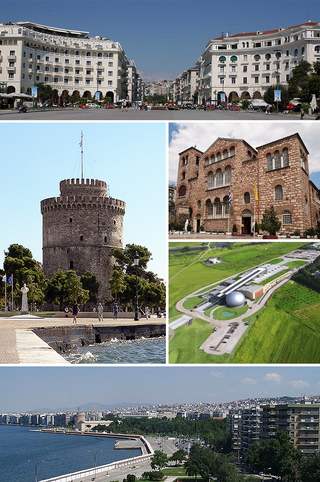
Thessaloniki, Saloniki, or Salonica, is the second-largest city in Greece, with over one million inhabitants in its metropolitan area, and the capital of the geographic region of Macedonia, the administrative region of Central Macedonia and the Decentralized Administration of Macedonia and Thrace. It is also known in Greek as η Συμπρωτεύουσα, literally "the co-capital", a reference to its historical status as the Συμβασιλεύουσα or "co-reigning" city of the Byzantine Empire alongside Constantinople.

Eastern Macedonia and Thrace is one of the thirteen administrative regions of Greece. It consists of the northeastern parts of the country, comprising the eastern part of the region of Macedonia along with the region of Western Thrace, and the islands of Thasos and Samothrace.
The Cretan Gendarmerie was a gendarmerie force created under the Cretan State, after the island of Crete gained autonomy from Ottoman rule in the late 19th century. It later played a major role in the coup that toppled the government of King Constantine in 1916, and also in the World War II Battle of Crete and the Greek Resistance that followed.

Serres is one of the regional units of Greece, in the geographic region of Macedonia. It is part of the Region of Central Macedonia. Its capital is the city of Serres. The total population reaches just over 175,000.

Macedonia is a geographic and former administrative region of Greece, in the southern Balkans. Macedonia is the largest and second-most-populous Greek geographic region, with a population of 2.36 million in 2020. It is highly mountainous, with most major urban centres such as Thessaloniki and Kavala being concentrated on its southern coastline. Together with Thrace, and sometimes also Thessaly and Epirus, it is part of Northern Greece. Greek Macedonia encompasses entirely the southern part of the wider region of Macedonia, making up 51% of the total area of that region. Additionally, it forms part of Greece's borders with three countries: Bulgaria to the northeast, North Macedonia to the north, and Albania to the northwest.

Alexandreia or Alexandria (Greek: Αλεξάνδρεια, Aleksándreia [ale'ksaŋðria]; before 1953: Gidas is a city in the Imathia regional unit of Macedonia, Greece. Its population was 14,821 at the 2011 census. Alexandreia is a rapidly developing city focusing to boost its economy through agriculture, merchandising, alternative tourism and other alternative actions.

Agios Athanasios is a town and a former municipality in the Thessaloniki regional unit, Greece. Since the 2011 local government reform it is part of the municipality Chalkidona, of which it is a municipal unit. In 2011 the population was 14,753. The municipal unit Agios Athanasios has an area of 155.34 km2, and the community Agios Athanasios has an area of 35.527 km2.

Nestorio is a village and a municipality in the Kastoria regional unit of Macedonia, Greece. Nestorio is approximately 28 km (17 mi) southwest of Kastoria, at the banks of the river Aliakmon.

The history of the Jews of Thessaloniki reaches back two thousand years. The city of Thessaloniki housed a major Jewish community, mostly Eastern Sephardim, until the middle of the Second World War. Sephardic Jews immigrated to the city following the expulsion of Jews from Spain by Catholic rulers under the Alhambra Decree of 1492. It is the only known example of a city of this size in the Jewish diaspora that retained a Jewish majority for centuries. This community influenced the Sephardic world both culturally and economically, and the city was nicknamed la madre de Israel.
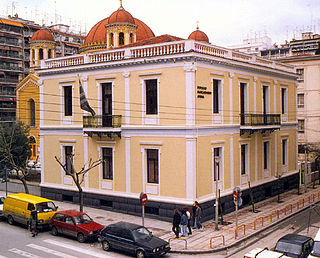
The Museum for the Macedonian Struggle is located in the centre of the city Thessaloniki in Central Macedonia, Greece. It occupies a neo-classical building designed by the renowned architect Ernst Ziller and built in 1893. In its six ground-floor rooms the museum graphically illustrates the modern and contemporary history of Greek Macedonia. It presents the social, economic, political and military developments that shaped the presence of Hellenism in the region. This approach enables the visitor to form a global picture, not only of the revolutionary movements in the area, but also of the rapidly changing society of the southern Balkans and its agonizing struggles to balance between tradition and modernization.

The Railway Museum of Thessaloniki is a museum in Eleftherio-Kordelio, a municipality of the city of Thessaloniki, Central Macedonia, Greece. It was founded in 2001 and is housed in the old Military Railway Station A of the Thessaloniki-Constantinople Railway, near the current TX-3 signalbox. This historic station was built in 1891–1894 by the Italian architect Pietro Arrigoni.

Kilkis is a city in Central Macedonia, Greece. As of 2011 there were 22,914 people living in the city proper, 28,745 people living in the municipal unit, and 51,926 in the municipality of Kilkis. It is also the capital city of the regional unit of Kilkis.

The railway from Thessaloniki to Bitola is a 219 kilometres (136 mi) long railway line, that connects the port city Thessaloniki in Greece with Bitola in the Republic of North Macedonia, via Veroia, Edessa, Amyntaio and Florina. The line was opened in 1894 under the name "Société du Chemin de Fer ottoman Salonique-Monastir", when the area was part of the Ottoman Empire. The section between the international border and Bitola is not used anymore, and as of 2013 passenger services are restricted to the section between Thessaloniki and Florina. The easternmost section of the line, Platy–Thessaloniki, is part of the important connection towards Athens and Northern Greece.
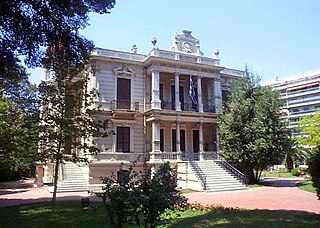
The Municipal Art Gallery of the Municipality of Thessaloniki in Central Macedonia, Greece was founded in 1966 as an offshoot of the Municipal Library. Since 1986 it has been housed in the Villa Mordoch on Vassilissis Olgas Avenue, a mansion designed by the architect Xenophon Paionidis in the eclectic style in 1905 and owned by the Municipality of Thessaloniki. Since 2013 it is housed in Villa Bianca, also on Vassilissis Olgas Avenue. It also uses the Makridis Room near the Posidonio sports centre on the sea front and the old Archaeological Museum as permanent exhibition spaces.
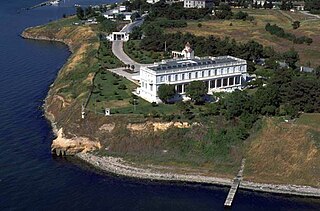
The Palataki is the popular name for a large neoclassical mansion in the Karabournaki area of the municipality of Kalamaria. Officially it is known as the Government House (Κυβερνείο).

Vitaliano Poselli (1838–1918) was an Italian architect from Sicily, mostly known for his work in the city of Thessaloniki in northern Greece.

Villa Bianca or Villa Fernandez is the name of a famous mansion in the city of Thessaloniki, Greece. It is located in Vassilisis Olgas street and was built between 1911 and 1913 as a residence for Dino Fernandez Diaz and his family. The architect was Pietro Arrigoni.

The Allatini Mills is a large former industrial area in the city of Thessaloniki, Greece near Kalamaria district. The name comes from the famous Allatini flourmills founded by the Allatini family in the late 19th century.
Nomarhia is an under-construction metro station serving Thessaloniki Metro's Line 2. The station is named after the nearby Villa Allatini, which housed the administrative headquarters of the Prefecture of Thessaloniki. Prefectures were abolished in 2010 and the Villa now houses the regional administration of Central Macedonia, but the station name has remained. It is expected to enter service in 2023.
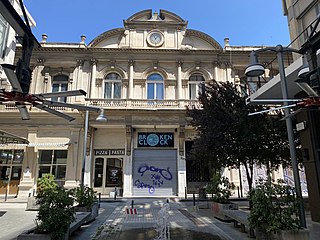
The Banque de Salonique was a regional bank headquartered in Thessaloniki and Istanbul. Created in 1886 under the initial leadership of the Salonica Jewish Allatini family with Austrian, Hungarian and French banking partners, it contributed to the development of the Eastern Mediterranean and Southern Balkans during the late Ottoman Empire. In the Interwar period its activity was mainly focused on Northern Greece, where it operated until the German occupation, and Turkey, where it kept operating until 2001, albeit under different names after 1969. Its preserved headquarters buildings are landmarks, respectively, of Valaoritou Street, a significant thoroughfare of downtown Thessaloniki, and of Bankalar Caddesi in the Karaköy neighborhood of Istanbul.